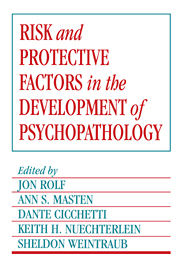Book contents
- Frontmatter
- Contents
- List of contributors
- Preface
- Part I Introduction: Historical and theoretical roots of developmental psychopathology
- Part II Contributions of the high-risk child paradigm: continuities and changes in adaptation during development
- Part III Competence under adversity: individual and family differences in resilience
- Part IV The challenge of adolescence for developmental psychopathology
- Part V Factors in the development of schizophrenia and other severe psychopathology in late adolescence and adulthood
- 18 Family relations as risk factors for the onset and course of schizophrenia
- 19 Long-range schizophrenia forecasting: many a slip twixt cup and lip
- 20 Vulnerability factors in children at risk: anomalies in attentional functioning and social behavior
- 21 Schizophrenia: a new model of its transmission and its variations
- 22 Premorbid competence and the courses and outcomes of psychiatric disorders
- 23 Relationships between adult development and the course of mental disorder
- A closing note: Reflections on the future
- Author index
- Subject index
20 - Vulnerability factors in children at risk: anomalies in attentional functioning and social behavior
Published online by Cambridge University Press: 06 August 2010
- Frontmatter
- Contents
- List of contributors
- Preface
- Part I Introduction: Historical and theoretical roots of developmental psychopathology
- Part II Contributions of the high-risk child paradigm: continuities and changes in adaptation during development
- Part III Competence under adversity: individual and family differences in resilience
- Part IV The challenge of adolescence for developmental psychopathology
- Part V Factors in the development of schizophrenia and other severe psychopathology in late adolescence and adulthood
- 18 Family relations as risk factors for the onset and course of schizophrenia
- 19 Long-range schizophrenia forecasting: many a slip twixt cup and lip
- 20 Vulnerability factors in children at risk: anomalies in attentional functioning and social behavior
- 21 Schizophrenia: a new model of its transmission and its variations
- 22 Premorbid competence and the courses and outcomes of psychiatric disorders
- 23 Relationships between adult development and the course of mental disorder
- A closing note: Reflections on the future
- Author index
- Subject index
Summary
The challenge of understanding the origins, precursors, and core abnormalities of schizophrenic disorders has led a number of investigators to the socalled high-risk method during the last three decades. To avoid confounding the consequences of these disorders with their causes and precursors, investigators have focused on individuals who are not manifesting schizophrenic disorders, but who are at increased risk for their development (Garmezy, 1974, 1978; Garmezy & Streitman, 1974). The most popular of these strategies has been the study of children born to a schizophrenic parent, whose risk for schizophrenia is known to be substantially higher than the population base rate. Estimates of the eventual incidence of schizophrenia among children of a schizophrenic parent range from 3% to 15%, depending on the breadth of the diagnostic criteria employed and other factors, an incidence 10 to 15 times the base rate for comparable populations (Gottesman & Shields, 1982; Kendler, Gruenberg, & Tsuang, 1985). In addition, considering the data from twin and adoption studies, one can assume that some offspring of a schizophrenic parent who do not develop schizophrenia nevertheless have an increased genetic vulnerability to such disorders.
The Minnesota High-Risk Studies, which were developed under the overall direction of Norman Garmezy and are part of a larger research program entitled Project Competence, have employed this research strategy in a series of investigations focusing on potential vulnerability factors and prodromal anomalies in schizophrenic disorders. This chapter integrates data from several studies in the final phase of the Minnesota High-Risk Studies. First, we shall present the overall subject recruitment strategy and the individual studies of attention and cognition that were completed during this phase.
- Type
- Chapter
- Information
- Publisher: Cambridge University PressPrint publication year: 1990
- 1
- Cited by

